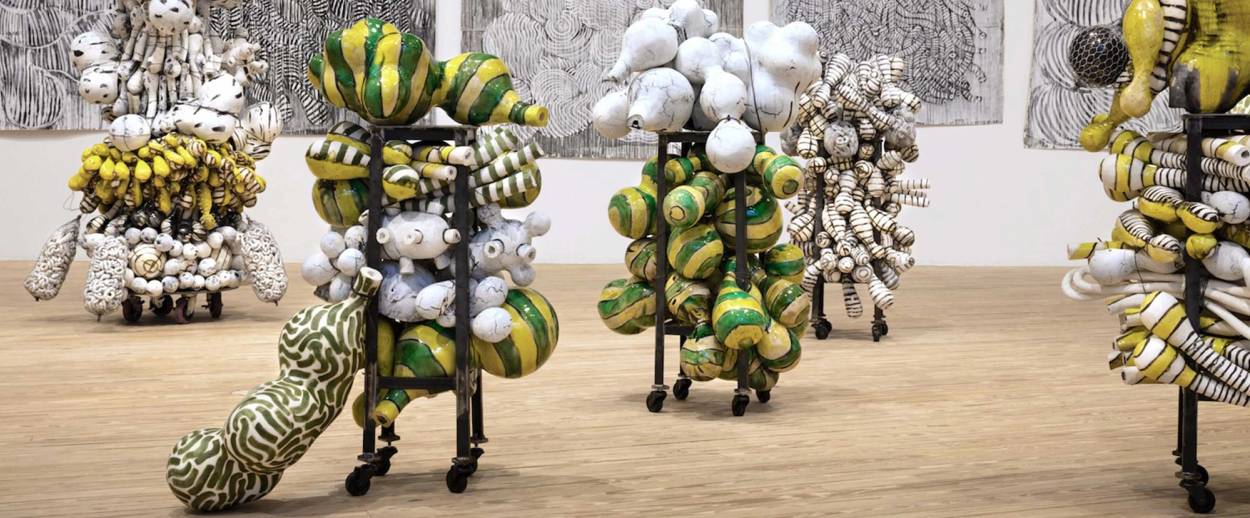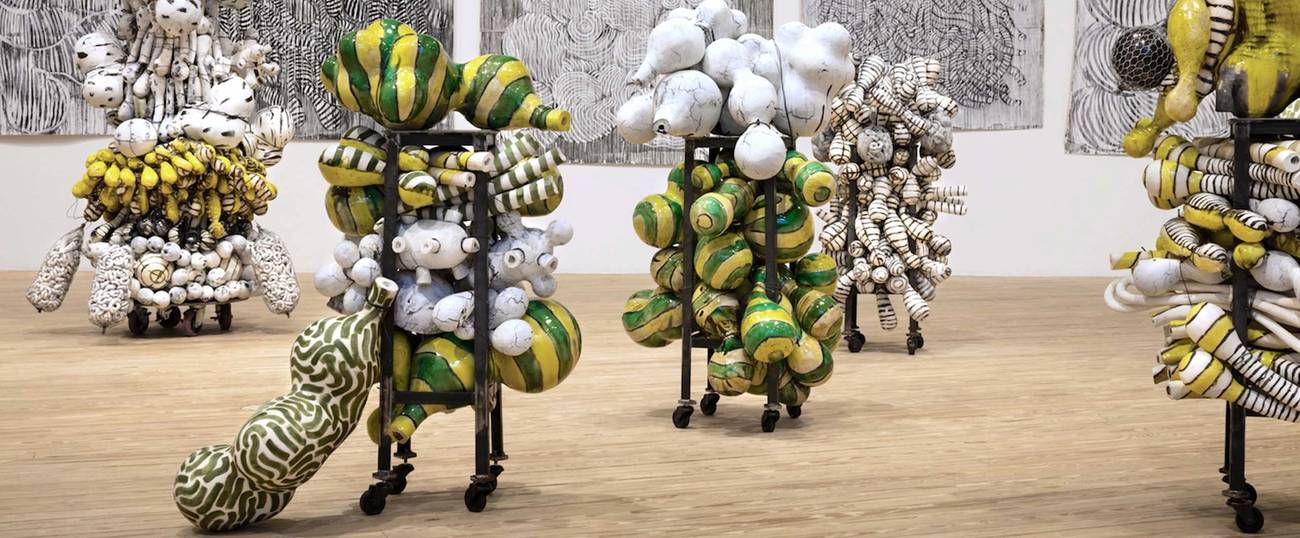The Ceramics of Annabeth Rosen
Recent shows in San Francisco and Houston of the artist’s assemblages demonstrate our ‘futile attempts of putting things together’




Respectable distance: that, and a certain creaky hush is what one expects, walking into a typical museum gallery hall. The space patrons give each other, and to the art they’ve come to see, is more than a courtesy or precaution. It is the very nature of the aesthetic experience as we know it—the physical and mental gap we insert between ourselves and the art we’ve come to observe. As I walked into “Fired, Broken, Gathered, Heaped,” Annabeth Rosen’s recent exhibit at the Contemporary Jewish Museum in San Francisco, however, I was immediately struck by the sight of someone hunched over one of the paintings, clearly modifying it. After a single speechless moment, I realized it was the artist herself, re-gluing sections of canvas with a Q-tip.
“I don’t wanna sound rude but this is more important,” she echoed, assertively, her thick Brooklyn accent cutting across the quiet gallery, in response to the curator’s gentle reminder about our interview. Before long, she was rearranging one of the larger, fragile ceramic installations on the other side of a large room. As the dutiful guard rushed over to her (“No touching!!”), she shot back, with a grin: “It’s OK! It’s mine.”
What I observed, in that moment of a memorable if unintended performance, as a small, smiling crowd gathered around Rosen, was the sense that the distance between the artist and her art, between the artist and her patrons, between strangers who found themselves standing and watching closely together, had momentarily closed. Rosen was in the process of evolving her work, and we were right there with her.
Born in New York, Annabeth Rosen, 63, has been living and working in California for over two decades. She is a professor at UC Davis, and specializes in ceramics, which constitute the core of the exhibit, although there are a number of paintings, which are featured as well. One of the most immediately striking aspects of her work is the fact that nearly every one of the ceramic pieces is an assemblage—a collection of small, colorful, oddly shaped, nonrepresentational objects joined together in a seemingly precarious way. And so, when we finally sat down to speak, the question of fragmentation was on my mind.
I asked Annabeth what drew her toward the decision to create in this particular fashion.
“It was never actually a decision,” she responded. “Art is a process: not the thing but the making of the thing and learning about the thing,” she added, bringing my thoughts back to her earlier tweaking and tinkering at the exhibit hall. She stressed her interest not only in the created, but also in the found, materials—in the “the remnant, the broken, and the leftover—the part that’s discarded and overlooked, and sometimes just as valuable. You’re working and making a considered arrangement but the pile on the floor is actually a so-much-more-interesting set of objects—just haphazardly, just by nature, how you set them down—that’s also your piece. So, if you recognize that you did that also then there’s a nice conversation that’s happening with the perception, or awareness that you’re trying to develop as an artist.”
A more traditional notion of “found objects” refers to peculiar artifacts of our civilization, which, if seen through the artistic lens, become art through the artist’s ability to bring our attention to them. It is less about creation or intention than it is about attunement to what can trigger an aesthetic experience.
Rosen’s peculiar twist on found objects is that she seems to find them in the margins of her own work. If art is about craft and iterative selection, hers is the ability to turn around and contemplate the unselected, unchosen, and seemingly uncrafted segments.
While many abstract visual artists choose to avoid naming their work, Rosen selects striking and deliberate names: “I name them what they look like,” she quipped, qualifying that name selection usually occurs after the piece is completed, much like a title for a poem is often selected after the writing of the poem itself.
One of the pieces in the exhibit is called “Boogaloo” and it is a somewhat roundish whole object, ridden with grooves or scars. It seems to resemble a skull, or maybe a slab of flesh, or an underwater, alien-like creature. “Boogaloo” is a word for something that doesn’t quite exist in a material reality: It is an illusion, or a fear, or even just an idea. Sure, artists have often aimed to expand the realm of the knowable by naming that which exists between the cracks of language, or just past its edges. You can call it the ineffable—but to name it “Boogaloo” is far more ironic and folksy. When I pointed out that a few of the assemblage names are words that do not exist—“Plu,” “Brundle”—she exclaimed, pointing at the catalog: “Well they do exist, don’t you see them written here on the page?”
Not all of her titles are ironic, of course. The title of the exhibit itself, “Fired, Broken, Gathered, Heaped,” refers, on the surface level, to the process of making ceramic objects—particularly the assembled ones. Inside the walls of the Contemporary Jewish Museum, however, such a title bears far more ominous historical and political undertones. Moreover, the title offers an opportunity for thinking and rethinking of Rosen’s work, and even the fragile medium of ceramics itself: Could it be that our fascination with it as an art form has something to do with its fragility—the fragility that reminds us of our own?
The name of the exhibit, it turns out, came from Rosen’s curator, Valerie Cassel Oliver, who assembled an earlier version of this particular collection at the Contemporary Arts Museum in Houston. Rosen explained: “There’s a collaborative aspect of being an artist. You get to talk to a poet who’s writing about your work. Or you get to work with a photographer,” who is photographing the sculptural objects. “We also have curators who dream through your work. See the world through your work. It’s a very unique, very remarkable, very wonderful, very privileged experience, when someone sees like you see, or close enough to have a serious conversation about it.”
As a professor, Rosen finds herself surrounded by others: “I teach students, and there is an underlying conversation going on always—lots of different people and different ideas. You have to read a hundred different things to be aware and prepared for dozens of conversations I’ll have in a day or a week, whether with colleagues or students.” She talks about being with others in a way that’s reminiscent of how objects come together in her ceramic assemblages, and all of her cheerfully gritty, a touch awkward, and eerily familiar, odd bunches, which, she says, remind one of our “futile attempts of putting things together.”
Something about that thinking—of the way people and objects gather—struck me as distinctly urban, and resonant with the way Rosen talks about growing up in Brooklyn, in a “family of tinkerers.” She went on to reminisce: “My mom sewed and baked. Everybody was in constant motion. We’re all like that—fixing all the time. We never went on the airplane. We drove with the picnic blanket. Never went out to eat. Being mindful, careful, practical. There was a shul on the corner, and my nana kept kosher. It’s the stew I was cooked in.”
Rosen offers a process-oriented model of art-making where, as she put it, “you’re paying attention to the things around you all the time. You’re so acutely aware, you don’t see anything. … It’s like when you close your eyes at a concert to listen better.” And to that, she suddenly added, with a smirk: “If I ever write you a letter, you won’t be able to read my handwriting, but if you look at it and glance away you’ll be able to tell what I’m talking about. It’s subcellular recognition.”
***
You can help support Tablet’s unique brand of Jewish journalism. Click here to donate today.
Jake Marmer is Tablet’s poetry critic. He is the author of The Neighbor Out of Sound (2018) and Jazz Talmud (2012). His jazz-klezmer-poetry record Hermeneutic Stomp was released by the Blue Thread Music in 2013.
Jake Marmer is Tablet’s poetry critic. He is the author of Cosmic Diaspora (2020), The Neighbor Out of Sound (2018) and Jazz Talmud (2012). He has also released two jazz-klezmer-poetry records: Purple Tentacles of Thought and Desire (2020, with Cosmic Diaspora Trio), and Hermeneutic Stomp (2013).